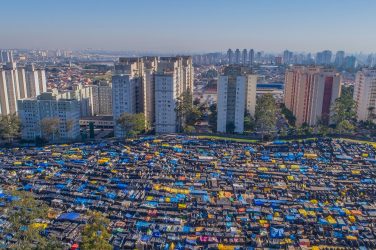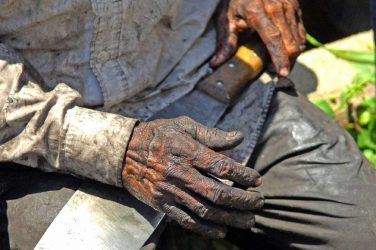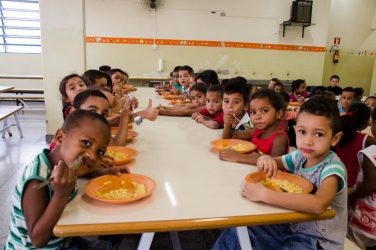 São Paulo’s mayor Fernando Haddad has a lot to finish up before he hands over Brazil’s biggest city to the incoming mayor, João Dória, on December 31, 2016. One urgent task: finally passing his long-debated affordable housing plan.
São Paulo’s mayor Fernando Haddad has a lot to finish up before he hands over Brazil’s biggest city to the incoming mayor, João Dória, on December 31, 2016. One urgent task: finally passing his long-debated affordable housing plan.
The city’s severe housing shortage particularly affects poor residents. According to recent data, at least 13,706 of its poorest households (those earning less than three times the monthly minimum wage of US$ 250) live in slums or squatter settlements. Another 53,214 share housing with other families, and 22,297 households live in overcrowded conditions.
Affordable housing is a key component of Mayor Haddad’s master plan for São Paulo, which was praised at the United Nations Habitat 3 conference in October for its emphasis on “social urbanism”.
To meet the needs of some 1.2 million homeless or precariously housed citizens, it calls for upgrading slums and granting land tenure to their residents, conversion of abandoned buildings, new construction and, critically, rent subsidies.

It’s scheduled for vote by the city legislature in the coming weeks, but approval is no guarantee it will be implemented. Dória won by campaigning to take the city in a different direction than his Workers’ Party predecessor. His urban development secretary has already promised to make housing regulations more “appealing” to real estate developers.
In Brazil, a nationwide emphasis on home ownership has failed markedly to provide housing for the country’s poorest. Unlike the United States and Europe, where a significant part of housing inventory consisted of government-owned rentals, Brazilian policy favors people buying, not renting, apartments.
The federal Minha Casa Minha Vida program (“My House My Life”), launched in 2009, aims to make home ownership accessible by providing high subsidies and low monthly installments. To date, 2.6 million units have been built.
Poor households face numerous obstacles to home ownership. Minha Casa Minha Vida has eased the legal requirements of contracts, as people working and living in the informal sector often cannot provide proof of income and other required documentation.
But families that earn meager wages in informal jobs as street vendors or domestics may find it just as difficult to stay in their homes. According to the University of São Paulo’s LabCidade, an urban planning think tank, the lowest-earning Minha Casa Minha Vida beneficiaries struggle to pay even reduced utilities and condo fees.
Among poor people who do manage to keep their homes, Minha Casa Minha Vida has unintentionally sent many into urban exile. The same LabCidade report showed that from a majority of the program’s most affordable big-city units are located in the outskirts, where land prices are lower. Thus many of its poorest beneficiaries are stranded far from downtown job opportunities and public transportation.
Those who purchase homes more centrally located in expensive cities often end up acceding quickly to real estate pressure. São Paulo real estate prices went up 153% between 2009 and 2012. Beneficiaries often resell their units, indirectly transferring public subsidies to better-off families, while the poorest return to substandard living conditions.
Home ownership as an affordable housing strategy has the additional downside of limiting residential mobility. That is, unemployed or underemployed home owners have less flexibility to pursue job opportunities, because they’re attached to a specific neighborhood for the medium- or long-term.
For Brazil to serve the needs of its poorest citizens, it must complement the home ownership system with alternative ways to access housing. Rent subsidies, like those proposed in Haddad’s housing plan, are critical. But I’m also looking internationally for successful models that Brazil could emulate.
Collective ownership, in which residents co-own properties, is an affordable housing model common in Uruguay and other Latin American countries. Co-ops would have great advantages for Brazil, with its organized housing movements and squatters who occupy numerous abandoned buildings in cities across the country.
Community-based land trusts, which finance nonprofit organizations to build and manage housing developments on behalf of a community, would also be a beneficial addition. This approach has been successful in offering affordable access to housing and land in the US, with pilots in Kenya and elsewhere, according to the United Nations.
Finally, there are housing projects. Despite its well-documented imperfections, the New York City Housing Authority is an important example of successful, affordable housing policy.
Simply having a municipal entity tasked with public housing is a feat. Brazil has nothing of the sort. It also provides a model for selecting tenants, financial management of public properties and, critically, allowing poor people to live in wealthy neighborhoods.
São Paulo does have some experience in this realm, to mixed results, as my research shows. In 2002 the city converted six buildings into public housing, including Parque do Gato project (“Cat’s Park”), to house unemployed people relocated from the slums, and Vila dos Idosos (“Seniors’ Village”), for retirees.
The former is now in a bad state of repair. The move was not accompanied by a jobs program, and approximately 70% of residents are unable to pay maintenance fees. Seniors Village, on the other hand, is well maintained; retirees’ fixed incomes have managed to keep payments up to date.
Brazil’s exclusive investment in buying property to build new housing as an affordable housing policy has ignored the needs of its poorest citizens and inflated the real estate market, according to a 2014 report, “benefiting primarily owners and investors and making it even more difficult for the low-income population to access adequate housing”.
If Mayor-elect Dória does not consider alternatives such as full rent subsidies, public housing and co-ops, he will fail São Paulo by repeating mistakes made with Minha Casa Minha Vida. Governments are not corporations. A city that only values profits and efficiency does so at the expense of real solutions for complex problems.
Simone Gatti is a postdoctoral researcher in Architecture and Urban Studies, University of São Paulo. She has received funding from the São Paulo Research Foundation (FAPESP) for her research.
This article was originally published on The Conversation. Read the original article at https://theconversation.com/to-house-its-poorest-brazil-must-go-beyond-home-ownership-and-look-abroad-for-inspiration-67437
![]()












